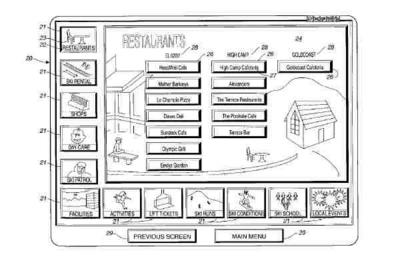'Aesthetically Pleasing' Screen Element Claim Invalid
 In Datamize, L.L.C. v. Plumtree Software, Inc. (Fed. Cir. August 5, 2005) the court held that the term "aesthetically pleasing," in each of the claims of U.S. Patent No. 6,014,137 (above) patent, fails to "particularly point out and distinctly claim the subject matter which the patentee regards as his invention," thus rendering the claims invalid under 35 U.S.C. § 112, ¶ 2.
In Datamize, L.L.C. v. Plumtree Software, Inc. (Fed. Cir. August 5, 2005) the court held that the term "aesthetically pleasing," in each of the claims of U.S. Patent No. 6,014,137 (above) patent, fails to "particularly point out and distinctly claim the subject matter which the patentee regards as his invention," thus rendering the claims invalid under 35 U.S.C. § 112, ¶ 2.The patent’s only independent claim recited a method for defining interface screens that are customized for individual kiosks. The method included the step of providing a plurality of pre-defined interface screen element types that permit limited variation within a "desired uniform and aesthetically pleasing look and feel" for the screens on all kiosks.
Although not discussed in the patent, the language was discussed during prosecution of a continuation application. The examiner reviewing that continuation application rejected a claim as being indefinite for using the phrase "aesthetically pleasing," and, in response the applicant argued that the phrase was definite:
Ultimately, the phrase was deleted with a statement that it was "not intended to identify qualities separate and apart from the remainder of this claim element" and was "superfluous and unnecessary." But that did not prevent the court from commenting on the file history:The attorney prosecuting the ’040 patent responded to a rejection for
indefiniteness of the phrase "aesthetically pleasing" by making the following
statements:In context "aesthetically pleasing look and feel" is that which is "desired,"
"chosen," or "predetermined" for uniform appearance. It does not call for the subjective application of some external standard of aesthetics.The "aesthetically pleasing" language is not itself intended to imply
judgment on the relative artistic merits of the "look and feel."[O]ne practicing the invention can create an "aesthetically pleasing look and feel" that is "desired" by that person and that is maintained as desired on screens of the system.
Whether the system creator’s sense of aesthetics complies with some other standard of beauty or good taste is irrelevant to the claims.
[T]he "aesthetically pleasing" language is not intended to identify qualities separate and apart from the remainder of this claim element. Accordingly, the deleted language is superfluous and unnecessary to the claims.
These statements merely confirm the understanding derived from the context ofNeedless to say, Datamize was unable to offer any intrinsic evidence of an objective standard for determining when an interface screen is "aesthetically pleasing." As noted by the court,
the claims and the specification: that the phrase "aesthetically pleasing" fails
to delineate the scope of the invention using language that adequately notifies
the public of the patentee’s right to exclude. By arguing that "aesthetically
pleasing" does not depend on any standard of aesthetics other than a purely
subjective standard held by any person who steps into the role of the system
creator, the prosecuting attorney would eliminate any objective meaning for the
phrase "aesthetically pleasing."
But that didn't stop Datamize from hiring an expert, Jeremy Rosenblatt, who testified in a declaration that persons of ordinary skill in the relevant art would recognize that "[t]he terms ‘aesthetic’ and ‘aesthetically pleasing’ in the patent serve to make it clear that the motivation of limiting selection is to allow the system creator to enforce his/her will regarding the ‘look and feel’ and aesthetic aspects rather than solely functionality." He even provided a list of what he denominated "generally accepted" parameters of design that contribute to a display getting high marks from users for being "aesthetically pleasing." That list included symmetry, consistency, predictability, simplicity, cleanliness, and non-crowdedness.Simply put, the definition of "aesthetically pleasing" cannot depend on an undefined standard. See Amgen, 314 F.3d at 1342 (finding indefinite claim requiring comparison to moving target since the patent failed to direct those of ordinary skill in the art to a standard by which the appropriate comparison could be made). Reference to undefined standards, regardless of whose views might influence the formation of those standards, fails to provide any direction to one skilled in the art attempting to determine the scope of the claimed invention. In short, the definition of "aesthetically pleasing" cannot depend on the undefined views of unnamed persons, even if they are experts, specialists, or academics. Thus, the written description does not provide any reasonable, definite construction of "aesthetically pleasing."
Who would have guessed? But, then again, isn't that the point of the definiteness requirement?

1 Comments:
Listen to the Datamize v. Plumtree Software on your iPod or MP3 player.
Post a Comment
<< Home
© 2004-2007 William F. Heinze